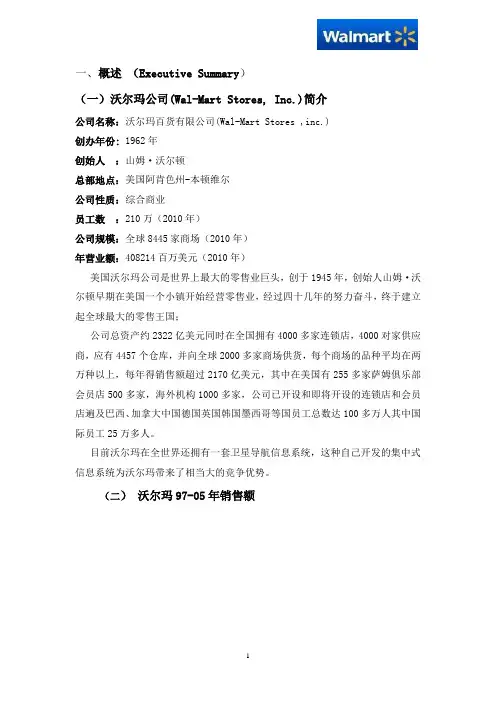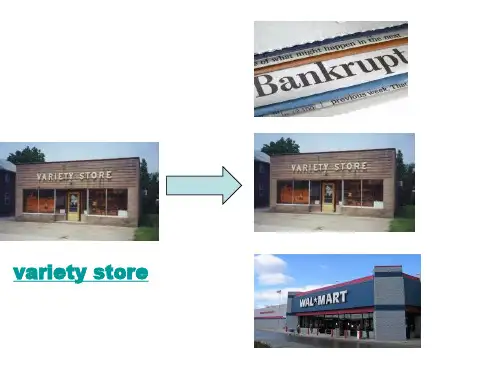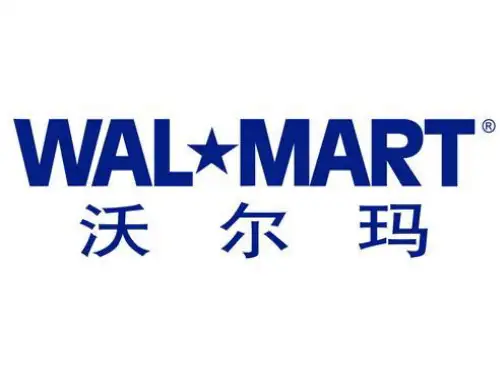沃尔玛英文简介
- 格式:ppt
- 大小:903.50 KB
- 文档页数:14


一、概述(Executive Summary)(一)沃尔玛公司(Wal-Mart Stores, Inc.)简介公司名称:沃尔玛百货有限公司(Wal-Mart Stores ,inc.)创办年份: 1962年创始人:山姆·沃尔顿总部地点:美国阿肯色州-本顿维尔公司性质:综合商业员工数:210万(2010年)公司规模:全球8445家商场(2010年)年营业额:408214百万美元(2010年)美国沃尔玛公司是世界上最大的零售业巨头,创于1945年,创始人山姆·沃尔顿早期在美国一个小镇开始经营零售业,经过四十几年的努力奋斗,终于建立起全球最大的零售王国;公司总资产约2322亿美元同时在全国拥有4000多家连锁店,4000对家供应商,应有4457个仓库,并向全球2000多家商场供货,每个商场的品种平均在两万种以上,每年得销售额超过2170亿美元,其中在美国有255多家萨姆俱乐部会员店500多家,海外机构1000多家,公司已开设和即将开设的连锁店和会员店遍及巴西、加拿大中国德国英国韩国墨西哥等国员工总数达100多万人其中国际员工25万多人。
目前沃尔玛在全世界还拥有一套卫星导航信息系统,这种自己开发的集中式信息系统为沃尔玛带来了相当大的竞争优势。
(二)沃尔玛97-05年销售额二、沃尔玛零售战略的SWOT 分析(一)内部分析(Internal Analysis)1、优势分析(Strengths )(1)节约开支,天天平价,成本领先企业的经营理念,不仅仅是企业的灵魂,同时也是企业经营成败的主要因素。
沃尔玛的经营理念蕴含于其“天天平价,始终如一”的经营策略中。
“天天平价,始终如一”不仅是指一种或若干种商品低价销售,而是所有商品都以最低价销售;不仅是指在一时或一段时间低价销售,而是常年都以最低价格销售;不仅是在一地或一些地区低价销售,而是所有地区都以最低价格销售。
(2)物流循环,提高效率沃尔玛将涉及采购、存货、运输等各个点在内的物流循环链条,作为实施成本领先战略的载体,并通过对该链条的集中管理,把整个链条中各个点的成本降至行业最低。









沃尔玛:全球零售巨头的崛起与影响Walmart, a multinational retail corporation, has emerged as a global leader in the retail industry, revolutionizing the way people shop worldwide. Founded by Sam Walton in 1962, Walmart has grown exponentially to become the largest private employer in the world, with over 2.2 million employees across the globe. The company's success can be attributed to its innovative business model, customer-centric approach, and relentless pursuit of cost-efficiency.Walmart's business model is unique in its ability to offer a wide range of products at low prices. By leveraging its scale and purchasing power, Walmart is able to negotiate better deals with suppliers, passing the savings onto its customers. This strategy has enabled Walmart to establish itself as a one-stop shopping destination for consumers, offering everything from groceries toelectronics at affordable prices.The company's customer-centric approach is evident in its commitment to providing exceptional service and convenient shopping experiences. Walmart stores aredesigned to be user-friendly, with clear signage, ample parking, and helpful staff. Additionally, the company has embraced technology to enhance the shopping experience, offering online shopping, mobile apps, and in-store pickup options.Walmart's commitment to cost-efficiency is reflected in its meticulous supply chain management and lean operations. The company has implemented advanced logistics systems to ensure timely delivery of goods to its stores, minimizing inventory costs and wasted resources. Walmart also focuses on sustainable practices, reducing its environmental impact and operating more efficiently.Beyond its financial success, Walmart has had a significant impact on the global economy and society. The company's vast supply chain has created millions of jobsfor suppliers, manufacturers, and distributors, driving economic growth and development in many regions. Walmarthas also been a champion of corporate social responsibility, investing in community development, education, and environmental conservation efforts.However, Walmart's rise to global prominence has not been without controversy. The company has faced criticismfor its impact on small businesses, wage practices, andlabor standards in some of its supply chain locations. These issues have prompted Walmart to reevaluate its business practices and implement changes to addressconcerns and improve its social and environmental footprint. Despite these challenges, Walmart remains a powerful force in the retail industry, shaping the way people shop and businesses operate globally. The company's success is a testament to its innovative business model, customer-centric approach, and commitment to cost-efficiency. As Walmart continues to evolve and adapt to changing market conditions, it remains to be seen how it will continue to shape the future of retail.**沃尔玛:全球零售巨头的崛起与影响**沃尔玛作为一家跨国零售企业,已经在全球零售行业中崭露头角,彻底改变了人们的购物方式。
介绍沃尔玛公司总体英语作文Walmart: An American Retail Giant Walmart, a name synonymous with everydaylow prices and vast product selection, stands as a titan in the global retail landscape. Founded by Sam Walton in 1962, this Arkansas-based behemoth has grownto become the world's largest company by revenue, with over 10,500 stores across24 countries. Its ubiquity and impact on consumer behavior, economic trends, and global supply chains make it a fascinating subject for analysis. Walmart's core business model hinges on its unwavering commitment to offering the lowest possible prices, achieved through aggressive cost-cutting measures and leveraging its colossal size to negotiate rock-bottom prices from suppliers. This relentless pursuit of value has resonated deeply with consumers, especially those seeking affordable essentials and household goods. The company's "everyday low prices" strategy has redefined consumer expectations, forcing competitors to adapt or perish in the wake of its relentless price wars. Beyond its pricing strategy, Walmart's success can be attributed to its comprehensive and strategically-designed supply chain. The company operates a vast network of distribution centers and utilizes sophisticated logistics technology to ensure efficient inventory management and swift product delivery. This meticulous approach to supply chain management not only minimizes costs but also allows Walmart to maintain stocklevels and meet consumer demand even during periods of high sales volume. However, Walmart's immense size and market dominance have also attracted criticism and scrutiny. Concerns regarding its labor practices, particularly wages and employee benefits, have been a recurring theme. Critics argue that the company's emphasison cost-cutting has come at the expense of its workforce, contributing to wage stagnation and limited career advancement opportunities. In addition, Walmart's environmental impact, particularly its contribution to waste generation and carbon emissions, has been subject to scrutiny, prompting the company to implement sustainability initiatives aimed at reducing its ecological footprint. Despite these criticisms, Walmart has demonstrably impacted local economies. Its massive scale necessitates a vast workforce, providing employment opportunities in both urban and rural communities. Furthermore, the company's presence often attracts other businesses to the area, stimulating economic activity and creating a rippleeffect of job creation. This economic impact, however, is not without its drawbacks. Critics argue that Walmart's entry into local markets often leads to the displacement of smaller, independent businesses that cannot compete with the retail giant's pricing power. Looking ahead, Walmart faces a dynamic and rapidly evolving retail landscape marked by the rise of e-commerce, shifting consumer preferences, and heightened competition from online giants like Amazon. In response, the company has strategically invested in its online presence, expanding its e-commerce platform and enhancing its delivery capabilities to cater to the growing demand for online shopping. Furthermore, Walmart has shown a willingness to experiment with new technologies, such as artificial intelligence and automation, to streamline its operations, enhance customer experience, and maintain its competitive edge. In conclusion, Walmart's story is one of ambition, innovation, and relentless pursuit of efficiency. Its evolution from a single discount store in rural Arkansas to a global retail behemoth reflects the company's adaptability and its keen understanding of consumer desires. While its practices have attracted criticism, Walmart remains a dominant force in the retail sector, continually adapting to changing market dynamics and striving to maintain its position as a leader in the global marketplace. Its future success hinges on its ability to balance its commitment to low prices with its responsibility towards its workforce, the environment, and the communities it serves.。